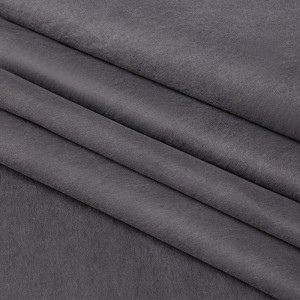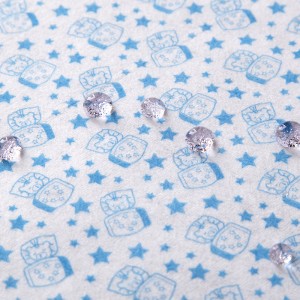Aerogel Spunlace Nonwoven Fabric
Segment market:
Ⅰ. Core Performance: Synergistic advantages of spunlace and aerogel
The performance of spunlace aerogel non-woven fabric is the result of the combination of the two technologies. Key characteristics include:
· Flexibility and skin-friendliness: The spunlace process interweaves fibers under high-pressure water flow, resulting in a soft and fine texture for the finished product, without any itchy sensation. It is suitable for direct contact with the human body or scenarios requiring folding and shaping.
· High-efficiency insulation + Lightweight: The nano-porous structure of aerogel gives the material an extremely low thermal conductivity (typically < 0.025 W/(m·K)), and the overall weight is light (30%-60% lighter than traditional insulation materials), without increasing the burden of use.
· Breathability and heat resistance: The porous structure of the spunlace non-woven fabric retains good breathability, avoiding the feeling of heat trapping; when combined with inorganic aerogels (such as silica), it can withstand temperatures above 600°C, and has flame-retardant properties.
· Easy processability: It can be cut, sewn, laminated, and is suitable for complex shape requirements, with no hair loss or balling, and good durability.
II. Typical application scenarios
1. Personal protection and wearable equipment
· Cold-weather protective clothing:
As an inner lining or layer for cold-weather clothing (such as winter coats, ski suits, and outdoor windbreakers), it provides efficient insulation in extremely cold environments (-20°C to -50°C), while maintaining the softness and breathability of the clothing, avoiding the constraining feeling caused by traditional thick fillers. For example: the close-fitting thermal layer for polar expeditions, high-altitude mountaineering, or lightweight cold-weather clothing for winter outdoor workers.
· High-temperature operation protection:
Used as inner linings for heat insulation gloves, wrist guards, and aprons in metallurgy, welding, and firefighting scenarios, it not only blocks high-temperature radiation (short-term tolerance up to 300-500°C) but also conforms to the human body's movements due to its softness, improving operational flexibility. Compared to traditional rigid heat insulation materials, it is more suitable for scenarios requiring frequent movement.
· Emergency rescue equipment:
Producing fireproof escape blankets and emergency heat insulation ponchos, which do not burn or drip when exposed to fire, and are lightweight and easy to carry, suitable for fire emergency protection in homes, shopping malls, etc.
2. Medical and health fields
· Cold-temperature medical insulation:
As an inner lining material for vaccine, biological sample, and blood transport boxes, it maintains a low-temperature environment (such as 2-8°C cold chain or -80°C deep cold) through efficient insulation, while due to the sterile nature of the spunlace non-woven fabric (can be disinfected), it avoids contamination of medical supplies. Its soft texture is also suitable for wrapping irregularly shaped medical containers.
· Post-operative care materials:
Used as the outer layer of wound dressings that require constant temperature protection, such as for burns and frostbite, it isolates external temperature stimuli while being breathable and not sweaty, reducing the risk of wound infection.
3. Industrial and equipment lightweight insulation
· Small equipment insulation layer:
Wrapping the shells of high-temperature instruments (such as laboratory ovens, portable heating devices) or the inner walls of low-temperature equipment (such as small refrigeration boxes, semiconductor cooling modules), achieving efficient insulation in limited space, and due to its flexibility, it can fit the curved surfaces of the equipment, without increasing the equipment's volume.
· Electronic component protection:
As heat insulation pads between battery cells (such as batteries for drones and small electric vehicles), it blocks heat transfer during battery charging and discharging, and due to its thin and light characteristics, it saves internal space in the battery pack and improves energy density; it can also be used as a heat insulation layer for high-temperature electronic components (such as LED lights, motors) to prevent heat from spreading to surrounding components.
4. Household and consumer products
· Appliance insulation components:
As insulation padding for the doors of microwave ovens, ovens, air fryers, or the hand grips of coffee machines and electric irons, reducing heat loss while maintaining the lightness and comfortable touch of the components.
· Household insulation products:
Producing baby sleeping bags, elderly thermal blankets, inner linings for outdoor camping sleeping bags, and inner linings for down jackets (which can be treated to prevent down loss), taking into account insulation, softness and skin-friendliness. Especially suitable for people who are sensitive to materials (such as infants, the elderly).
5. Special scene auxiliary materials
· Aerospace lightweight insulation: For the internal thermal insulation layers of small spacecrafts and unmanned aircraft, or the flexible thermal insulation components of astronauts' extravehicular spacesuits, it can reduce weight while resisting extreme temperature differences (from -100℃ to above 100℃).
· Automotive interior insulation:
As a thermal insulation pad between the engine compartment and the driver's cabin, or a thermal insulation layer for the interior of the car doors, it reduces the heat from the engine from entering the vehicle, while being soft and not generating abnormal sounds, thereby enhancing the driving comfort.
III. Application Advantages and Development Potential
The core value of aerogel spunlace non-woven fabric lies in balancing "efficient function" and "user experience" - it not only solves the problem of traditional aerogel's high brittleness and difficulty in processing, but also makes up for the shortcoming of ordinary spunlace non-woven fabric's lack of extreme temperature protection ability. With the decrease in the cost of aerogel and the maturity of spunlace composite processes (such as immersion method, spraying method), its application in civilian lightweight insulation, precision equipment insulation and other fields will be further popularized. Especially in scenarios with prominent demands for "flexibility + high performance", it is expected to gradually replace traditional insulation materials.













